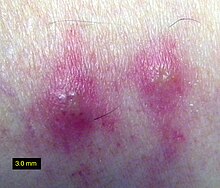Skin disease
| Classification according to ICD-10 | |
|---|---|
| L98.9 | Disease of the skin and subcutaneous tissue, unspecified |
| ICD-10 online (WHO version 2019) | |
A skin disease or disease (medical terms: dermatosis , dermatopathy , dermopathy ) is a disease of the skin . Skin diseases are treated in particular by a dermatologist (dermatologist).
Diseases of the skin appendages ( hair , nails , sebum and sweat glands ) are also counted among the skin diseases, since these structures, also known as adnexal organs, are of epidermal origin, even if they are partly deep in the dermis .
At some centers, dermatologists also treat AIDS , and venereologists also treat classic sexually transmitted diseases such as syphilis , as these diseases also manifest on the skin, but are not actually skin diseases. On the other hand, diseases from the field of phlebology or angiology with the resulting skin symptoms such as leg ulcer are also classified here.
No other organ in the human body shows such a high number of pathological changes as the skin. a. As a border organ of the human and animal body, it is exposed to a wide variety of internal and external influences.
Dermatological diseases
Symptoms and ailments
Many skin diseases attract attention because the skin looks different from healthy skin in that area. One also speaks of the so-called " efflorescences ". A distinction is the predominant primary such as spot ( macula ), nodules ( papule ), pus nodules ( pustule ), wheal ( Urtica ), node ( nodus ) or plaque from the secondary efflorescences such as crust , cracks ( fissure , Rhagade ), dander ( Squama ), ulcer . Some of these efflorescences are otherwise not noticeable, while others also cause severe discomfort (itching, burning, pain).
causes
As mentioned above, there are many different causes of skin diseases, which can also work together to trigger a skin disease. Many people have a hereditary predisposition to the development of psoriasis or atopic eczema (neurodermatitis). B. by stress or another infection, in addition, the course of the disease can worsen again by a bacterial or viral infection. In the case of many skin diseases, one still does not know the exact mechanism by which they develop, whereby in many cases regulatory disorders of the immune system and apoptosis are the causes.
Consequences and complications
The spectrum of the severity of skin diseases is just as broad as the spectrum of skin diseases themselves.
There are many "skin diseases" that z. B. are only cosmetically disruptive, but otherwise completely harmless (e.g. seborrheic keratosis or "old age wart").
Inflammatory skin diseases are often annoying with itching or pain. In addition, the psychological stress increases for many patients because they are very stigmatized by the skin disease.
Some skin diseases, such as B. skin cancer, if left untreated, can lead to death; black skin cancer ( malignant melanoma ) is in some cases incurable, even despite adequate treatment. Many skin diseases can also result in very serious therapies, which in turn become problematic due to their side effects.
treatment
Lighter skin conditions (such as an allergic rash ) can be treated with anti-inflammatory ointments or creams . Some of these ointments contain disinfecting ingredients or cortisone and should only be used for a short time because of their side effects . The advantage is that the active ingredient only works where it is needed; In addition, by choosing the right base (ointment, cream, paste, solution, lotion) additional effects can be achieved.
More serious skin diseases often do not respond to local therapy with ointments or creams alone. Systemic drugs , e.g. B. in tablet form, used, which can have side effects. Infectious diseases of the skin caused by bacteria or viruses also require the administration of antibiotics or similar agents.
Skin cancer is often operated on , in advanced cases also irradiated or treated with chemotherapy .
Literature, guides, textbooks
- Peter Altmeyer, Klaus Hoffmann: Basic knowledge of dermatology , W3L GmbH Herdecke 2006, ISBN 3-937137-95-5
- Bernd Kardorff, Maria Kardorff: Patient's guide and short lexicon of skin diseases, venous disorders, allergic diseases and cosmetic medicine . BOD 2002, ISBN 3831132380
- Otto P. Hornstein, Matthias S. Gruschwitz, Eckart Haneke: "Skin diseases and skin care in old age" , Wissenschaftliche Verlagsgesellschaft Stuttgart 2002, ISBN 3804718299
- Bernd Kardorff: Healthy Skin - Lexicon from A to Z. Springer Verlag Berlin Heidelberg, 2004, ISBN 3540205659
- Roland Niedner, Yael Adler: An eye on skin diseases for the smock pocket . Wissenschaftliche Verlagsges. 2004, ISBN 3804720455
- Otto Braun-Falco , Gerd Plewig , Helmut H. Wolff: Dermatology and Venereology . Springer Verlag Berlin Heidelberg, 2005, ISBN 3540405259 bla
- Britta Wulfhorst and Hans Joachim Schwanitz: Skin Diseases and Skin Protection , Munich April 2001
- Schwanitz, Szliska: occupational dermatitis , Munich 2001
- Constantin Orfanos, Claus Garbe (Ed.): Therapy of skin diseases: including allergology, andrology, phlebology, proctology, trichology, pediatric dermatology, tropical dermatoses and venereology and HIV infection and dermatological emergencies , 2nd edition, Berlin: Springer 2002, ISBN 3-540-41366-9 .
